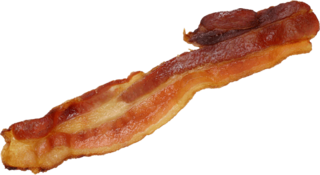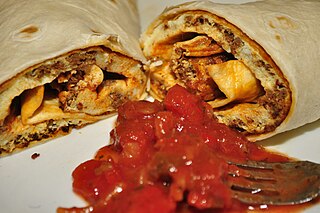
Bacon is a type of salt-cured pork made from various cuts, typically the belly or less fatty parts of the back. It is eaten as a side dish, used as a central ingredient, or as a flavouring or accent.

An omelette is a dish made from eggs, fried with butter or oil in a frying pan. It is a common practice for the omelette to be folded around fillings such as chives, vegetables, mushrooms, meat, cheese, onions or some combination of the above. Whole eggs or egg whites are often beaten with a small amount of milk, cream, or water.

A fried egg is a cooked dish made from one or more eggs which are removed from their shells and placed into a frying pan and fried. They are traditionally eaten for breakfast in many countries but may also be served at other times of the day.

Egg salad is a dish consisting of chopped hard-boiled or scrambled eggs, mustard, and mayonnaise, and vegetables often including other ingredients such as celery.

Scrambled eggs is a dish made from eggs stirred, whipped, or beaten together typically with salt, butter, oil, and sometimes other ingredients, and heated so that they form into curds.

Fried rice is a dish of cooked rice that has been stir-fried in a wok or a frying pan and is usually mixed with other ingredients such as eggs, vegetables, seafood, or meat. It is often eaten by itself or as an accompaniment to another dish. Fried rice is a popular component of East Asian, Southeast Asian and certain South Asian cuisines, as well as a staple national dish of Indonesia. As a homemade dish, fried rice is typically made with ingredients left over from other dishes, leading to countless variations. Fried rice first developed during the Sui Dynasty in China.

Migas is a dish traditionally made from stale bread and other ingredients in Spanish and Portuguese cuisines. Originally introduced by shepherds, migas are very popular across the Iberian Peninsula, and are the typical breakfast of hunters at monterías in southern Spain.

Frittata is an egg-based Italian dish similar to an omelette or crustless quiche or scrambled eggs, enriched with additional ingredients such as meats, cheeses, or vegetables. The word frittata is Italian and roughly translates to 'fried'.

The breakfast burrito, sometimes referred to as a breakfast wrap outside of the American Southwest, is a variety of American breakfast composed of breakfast items wrapped inside a flour tortilla burrito. This style was invented and popularized in several regional American cuisines, most notably originating in New Mexican cuisine, and expanding beyond Southwestern cuisine and neighboring Tex-Mex. Southwestern-style breakfast burritos may include any combination of scrambled eggs, potatoes, cheese, peppers, salsa, onions, chorizo, bacon, or sour cream. In other variations of breakfast burritos, more ingredients such as tomatoes, cheese, ham, and other fresh products can be added.

An egg sandwich is a sandwich with some kind of cooked egg filling. Fried eggs, scrambled eggs, omelette, sliced boiled eggs and egg salad are popular options. In the last case, it may be called an egg salad sandwich.

Diner lingo is a kind of American verbal slang used by cooks and chefs in diners and diner-style restaurants, and by the wait staff to communicate their orders to the cooks. Usage of terms with similar meaning, propagated by oral culture within each establishment, may vary by region or even among restaurants in the same locale.

Eggs 'n' brains is a breakfast meal consisting of pork brains and scrambled eggs. It is a dish of Portuguese cuisine known as omolete de mioleira. In Austria, the dish is known as Hirn mit Ei and used to be very common, but has seen a sharp drop in popularity.

The bocadillo or bocata, in Spain, is a sandwich made with Spanish bread, usually a baguette or similar type of bread, cut lengthwise. Traditionally seen as a humble food, its low cost has allowed it to evolve over time into an iconic piece of cuisine. In Spain, they are often eaten in cafes and tapas bars.

The cheese dream is an open-faced version of the American grilled cheese sandwich made with bread and cheese; it is cooked with either oil, margarine, or butter. Other ingredients such as bacon, avocado, pineapple, eggs, or sliced tomato can be optionally added to the open-faced sandwich as well.
Breakfast, the first meal of the day eaten after waking from the night's sleep, varies in composition and tradition across the world.






















